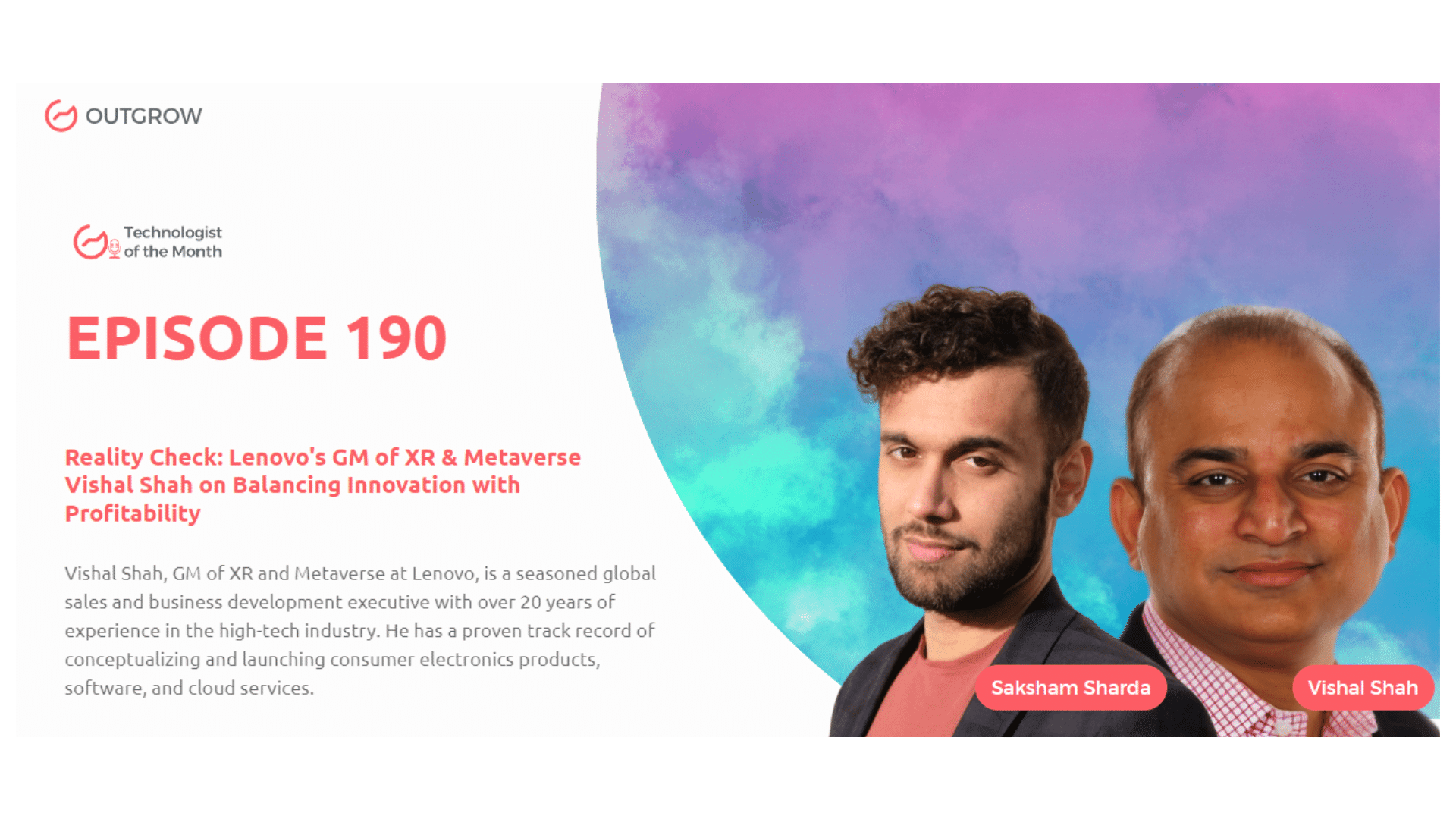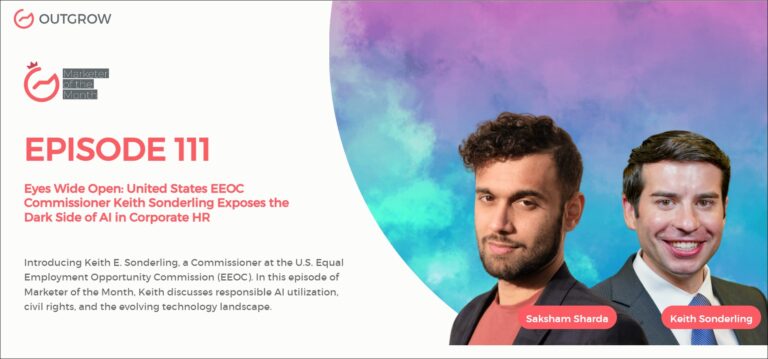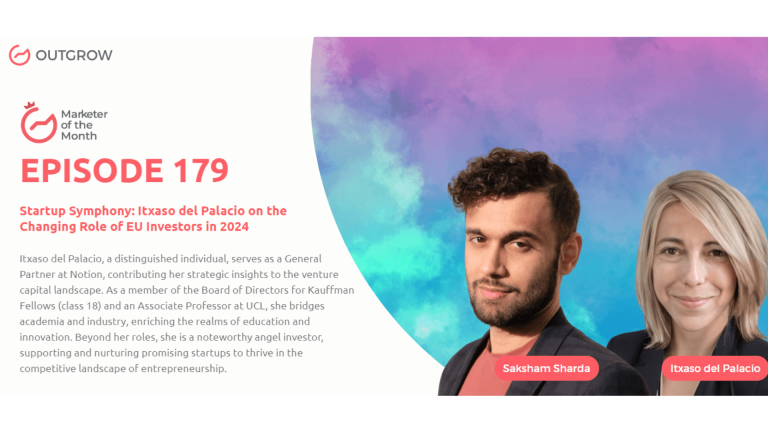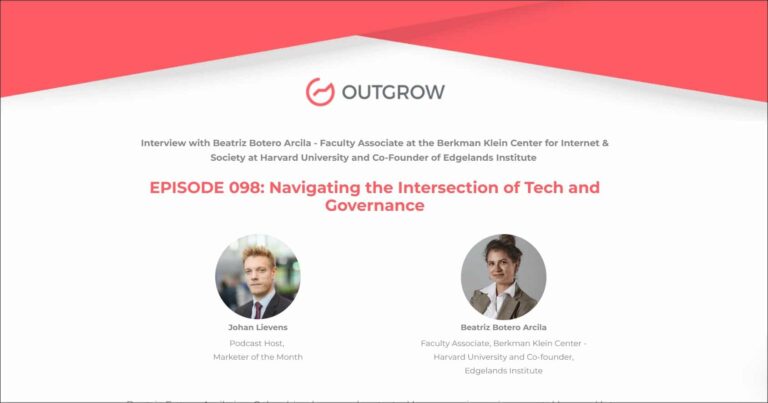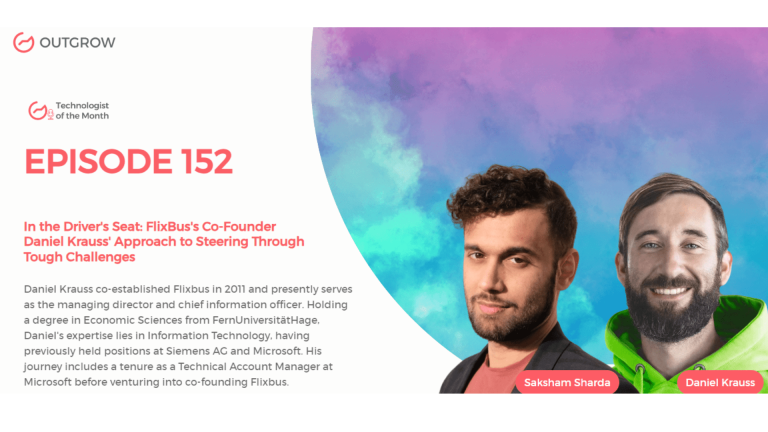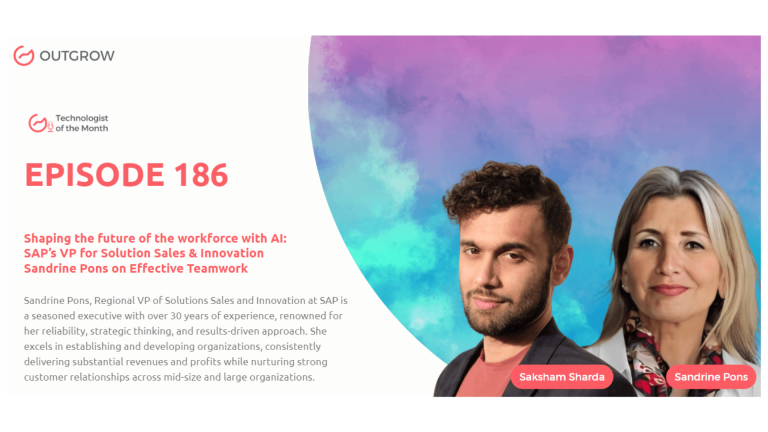EPISODE 190: Marketer of the Month Podcast with Vishal Shah
Table of Contents
Hey there! Welcome to the Marketer Of The Month blog!
We recently interviewed Vishal Shah for our monthly podcast – ‘Marketer of the Month’! We had some amazing insightful conversations with Vishal and here’s what we discussed about –
1. Consumer Foray: XR in gaming and AI-driven augmented reality.
2. Market Evolution: Advancements in chipsets for improved device efficiency.
3. Technological Challenges: Hardware efficiency and battery life improvements.
4. Key Drivers for IoT and Cloud: Enhanced learning experience and workforce onboarding.
5. Risk Mitigation Approach: Clear objectives, internal checkpoints, and robust cadence.
6. Impact of Generative AI: Accelerating content creation and reducing costs.
7. Product Planning Strategy: Focus on enterprise needs, simplicity, and ecosystem partnerships.
About our host:
Dr. Saksham Sharda is the Chief Information Officer at Outgrow.co. He specializes in data collection, analysis, filtering, and transfer by means of widgets and applets. Interactive, cultural, and trending widgets designed by him have been featured on TrendHunter, Alibaba, ProductHunt, New York Marketing Association, FactoryBerlin, Digimarcon Silicon Valley, and at The European Affiliate Summit.
About our guest:
Vishal Shah, GM of XR and Metaverse at Lenovo, is a seasoned global sales and business development executive with over 20 years of experience in the high-tech industry. He has a proven track record of conceptualizing and launching consumer electronics products, software, and cloud services.
Reality Check: Lenovo’s GM of XR & Metaverse Vishal Shah on Balancing Innovation with Profitability
The Intro!
Saksham Sharda: Hi, everyone. Welcome to another episode of Outgrow’s Marketer of the Month. I’m your host, Dr. Saksham Sharda, and I’m the creative director at Outgrow. co. And for this month we are going to interview Vishal Shah, who is the GM of XR & Metaverse at Lenovo.
Vishal Shah: Great to be here. Thank you.
Don’t have time to read? No problem, just watch the Podcast!
Challenge yourself with this trivia about the exciting topics Vishal Shah covered in the podcast
Or you can just listen to it on Spotify!
The Rapid Fire Round!
Saksham Sharda: Alright, so Vishal, we’re going to start with the rapid-fire round. Just to break the ice, you get three passes in case you don’t want to answer the question, you can just say pass. But try to keep your answers to one word or one sentence only. Okay?
Vishal Shah: Absolutely. Looking forward to it.
Saksham Sharda: Alright, so the first one is, at what age do you want to retire?
Vishal Shah: Never.
Saksham Sharda: How long does it take you to get ready in the mornings?
Vishal Shah: 15 minutes.
Saksham Sharda: Most embarrassing moment of your life.
Vishal Shah: My kids should answer that not me. Because That happens almost every day.
Saksham Sharda: Favorite color?
Vishal Shah: I would say blue.
Saksham Sharda: What time of day are you most inspired?
Vishal Shah: I start my days early. 5:00 AM.
Saksham Sharda: How many hours of sleep can you survive on?
Vishal Shah: Probably around five hours a day.
Saksham Sharda: Fill in the blank. An upcoming technology trend is ______.
Vishal Shah: I would say XR plus AI is the next-gen of computing.
Saksham Sharda: Alright, the city in which the best kiss of your life happened?
Vishal Shah: I would’ve to say Hawaii. I would say Maui.
Saksham Sharda: How do you relax?
Vishal Shah: Going on hikes.
Saksham Sharda: How many cups of coffee do you drink per day?
Vishal Shah: Too many.
Saksham Sharda: A habit of yours that you hate?
Vishal Shah: I would say Netflix binging on the weekends the
Saksham Sharda: The most valuable skill you’ve learned in life.
Vishal Shah: Being resilient and always being resilient.
Saksham Sharda: The biggest mistake of your career?
Vishal Shah: Not taking risks early on in my career.
Saksham Sharda: Your favorite Netflix show?
Vishal Shah: I would’ve to say Stranger Things.
Saksham Sharda: One-word description of your leadership style.
Vishal Shah: Inclusive. And always sharing and being a constant communicator.
Saksham Sharda: The top priority in your daily schedule.
Vishal Shah: Meeting customer commitments and making sure that my team is heard and taken care of.
Saksham Sharda: An ideal vacation spot for relaxation.
Vishal Shah: Anywhere close to the beach.
Saksham Sharda: The last one is a key factor for maintaining a work-life balance.
Vishal Shah: Prioritize family and friends.
Saksham Sharda: What is one piece of advice you would give job seekers in the current market?
Vishal Shah: Use your network. That’s the most important thing.
Saksham Sharda: Alright, so that’s the end of the rapid fire. Is there any rapid-fire question you want to elaborate on more? Or do you think you’re good?
Vishal Shah: I think we’re good.
The Big Questions!
Saksham Sharda: Alright. So we can go into the long-form questions for which you can take as much time and thought and anything you like. The first question is, how do you envision the future of XR and metaverse technologies shaping consumer electronics and mobile products in the next decade?
Vishal Shah: Yeah. So, you know I think reality, we are focused largely on the enterprise side of things. You know, we are working with large enterprise customers to help with worker safety with training and development, with collaboration. But when it comes to the consumer side, we’re already seeing a foray right now into gaming as well as AI-based you know, augmented reality glasses that help you in your daily life. So whether it’s consumer or enterprise, we feel that the overall market, as the technology evolves as chipsets get more efficient will make these devices more palatable. You’re gonna be able to wear them just like my glasses right now, for much longer periods. We are gonna see the same evolution happen in the VR glasses as well as we move to mixed reality. Right. But in terms of traction and ROI, we are seeing a lot of that happen more on the enterprise side first in terms of very tangible ROI that our enterprise customers are getting, you know, B2B and then eventually B2C as well.
Saksham Sharda: Are there any potential challenges or obstacles that these technologies may encounter in becoming mainstream components of consumer electronics or just mainstream in general?
Vishal Shah: Yeah, I think just like any technology curve, right? It’s about the solutions. It’s about the content, and then it’s about eventually the hardware getting to a point where you can wear these devices for long periods. Right. So we’ve always seen huge jumps in the hardware as you know, as we look at more and more of these new designs, if you look at our latest VRX reality, we are using the pancake lenses, which reduces the thickness by almost one third. We have a lot more comfortable designs that let these workers use these for one-hour training sessions or any kind of remote assistance work, but a lot more needs to be done if these devices were to be used for entire, you know, shifts, for example, right? For an eight-hour shift or for a complete movie. You know, they have to get a lot more efficient. They have to get a lot lighter and the battery life has to improve significantly as well. And, you know, hardware is just one problem. It’s also the killer user case use cases whether it’s on the enterprise side or the consumer side. I think it’s going to be important that the focus on key outcomes on the enterprise side, especially around learning and development collaboration, and the remote worker area is gonna be very important to make this technology scale.
Saksham Sharda: So in your opinion, what are the key factors driving the adoption of IoT and cloud software solutions in today’s high-tech industry?
Vishal Shah: The key factor that is driving this is the evolution of content, right? So if you look at the education market K through 12 and higher ed you know, there’s no doubt that students, millennials gen Z, they take to this 3D spatial computing a lot more than the previous generation. So their preferred method is to think in this 3D environment. And when you teach a particular worker or a student in a 3D environment with a digital twin using some of these ar VR technologies you know, your retention is 400% higher, your error rates come down significantly and you can actually teach your entire class in a much more efficient manner that they recall in a lot more, right? So those ROIs are quite clear. Those outcomes are quite clear. So we’re seeing a lot of excitement in that area. The other big area is around the workforce you know onboarding as well, right? As we see these baby boomers retire we are losing a lot of skills in the field or on the factory floor. And how do we bring the new generation that’s coming to replace these workers? How do we bring them off the bench in a safe manner and in a quick manner so that we can efficiently get them back to the factory floors or to the field? That’s where AR VR training is one of the best ways to train and onboard these employees in a more 3D format. So that when you’re trying to fly a plane, you don’t do it, you don’t get in the plane directly, you get into a simulator, right? So being able to simulate these tough jobs, being able to simulate a tough environment, hard skills, as well as soft skills building that, that muscle memory so that when you go to the factory floor for the first time, or when you interact with a customer, or when a nurse goes to a particular hospital room to configure it for the first time, it’s, you’re no stranger to that environment. You’ve actually done it in a more 3D spatial environment multiple times.
Saksham Sharda: So here, you mentioned auto education let’s say travel flights shipbuilding, or flight building. Are there any other industries where this is seeing application?
Vishal Shah: I already mentioned education and, again just in general research and development right, whether it’s you know, we’ve, we have a lot of companies in the healthcare space when they’re looking at a particular design of a stent or working through you know, a particular molecular design you know, we see them use ar via technologies and collaborate across multiple industries, multiple multiple continents to bring these together. Another interesting area is quick-service restaurants, right? So you know, restaurants that serve through drive-throughs and in a very high-stress environment tend to have a very high return and very high churn rates in terms of people coming and leaving their jobs in 30 days, 90 days. So the question is, how can you because it’s a very high-stress environment? So the question is, how can you train these folks so that they get onboard faster, that they enjoy what they’re doing and how can you gamify the training so that they get more used to these high-stress environments? So we are seeing a lot of quick service restaurants adopt this technology to make sure that their employees get you know, get trained on the latest technology as well as you know, have the right kind of training to kind of maintain their cool in this high-stress environment.
Saksham Sharda: Speaking of all these applications, as a successful GM with p and l responsibility, how do you balance innovation and profitability when developing new products and services like these?
Vishal Shah: Yeah, you know, it’s all about the outcomes that we focus on when it comes to innovation. You know, Lenovo has, you know, one of the best track records in innovation being a true pocket-to-cloud company and the number-one PC player in the world. And now we’re seeing this huge inflection with IPCs and AI on the edge as well, right? So innovation is in our DNA. We, in our industry, get to partner with some of the top component makers in the world, like Qualcomm. We were sometimes their lead partners on their chipset roadmap for XR. We were their lead partner on Qualcomm’s Snapdragon Spaces ecosystem as well which really helped us build a large ecosystem as well. So I think innovation is always something that we’re looking to you know, really we lead with innovation and we lead with solutions. So I think that the other part of the innovation is not only about the hardware or the technology, it’s about creating that ecosystem, an open ecosystem where your ISVs and solution providers can thrive and provide these end-to-end solutions to your end customers. So I think that a key part of innovation is the business model that you create that reduces the friction to onboard these solution providers so that we can serve our customers better. And then the third part of the innovation, of course, is having a suite of services and a global reach as well, right? So Lenovo, one of the things that’s in our DNA is because of our brand, because of our you know, because of the trust we have with the largest CIOs and enterprises in the world you know, we have operations in more than 180 countries. We have a very diversified supply chain. So when our customers adopt a new technology like AR VR, which is still very nascent they know that, you know, we will be able to serve them in multiple countries. We will be able to provide them with services, provided we will be able to provide them with warranties and replacements in these countries. And, you know, we will have a continuous roadmap that serves them over the next five to 10 years as well.
Saksham Sharda: It seems like a lot of stuff on your plate. So how do you approach risk assessment and mitigation when pursuing such innovative ventures in your control?
Vishal Shah: Yeah, I mean, that’s a great question. You know, every day is about risk mitigation and control, right? Especially in a new industry, in an industry that’s changing, you know by the hour sometimes in ar vr, right? So it’s kind of like the early days of AI. You know, we’ve been through a lot of the hype cycles, the highs and the lows. You know, there’s always a challenge with component providers. There’s always a challenge with you know the ISVs that we work with. But, you know, when it comes to risk mitigation, you know, we make sure that we have a very clear set of objectives. We have checkpoints with all our internal project leads, internal service providers, as well as external vendors. And we have a very strong cadence that that is kind of, you know, it’s gonna, it’s the Lenovo approach to make sure that we provide the right kind of quality security and privacy, right? So one of the big things about the risk mitigation that we do is our commitment to being a pure enterprise first company and a PR enterprise, first platform for ar vr, unlike some of our other, unlike some of the other players in the market who have more have a gaming or social media, DNA, they come with that with, with, with that first, and, use this in the enterprise as well, which just doesn’t work, right? Because our customers are looking for a lot more stringent standards and someone with a track record of security and privacy. So that is gonna become extremely important, especially in the AI world as we start integrating more and more gen AI solutions in VR, both from content development as well as a co-pilot assistant as well.
Saksham Sharda: And so, speaking about these innovations and emerging trends, could you discuss the potential synergies between XR technology that you talked about and emerging trends such as edge computing and decentralized finance?
Vishal Shah: Yeah, absolutely. So, I think, you know, the overall promise of the Metaverse, right, was the combination of XR and decentralized worlds and decentralized finance being able to bring that together, right? So a lot of that you know, is still evolving as we go forward. But, you know, one of the key areas that we are focused on, of course, is the XR plus Edge that he talked about, and XR plus ai we just demonstrated you know, a multi-VR solution at the Nvidia conference, the GTC where we demonstrated up to four VR headsets being powered of the same edge workstations so that you can collaborate in a 3D format on different parts of the world, right? So we’re already seeing that if you wanna make these devices smaller, more and more of these digital twins will have to live on the edge and be delivered to your device on demand using, you know, a 5G low latency network. So edge is gonna be a key part of the offloading of a lot of this a lot of this content, a lot of this data for these devices to get more you know more sleek at the same time, more efficient as well. And then, you know, the second part, of course, when it comes to these new technologies is gonna be around generative AI. You know, that’s gonna be a huge inflection point for this industry, and it already is especially around the ability to build content. To me, one of the biggest things that’s required to scale in this industry is the availability of content. And a lot of content needs to be spatially 3D immersive and that requires a lot of you know, it’s a high-budget project, right? Because you need designers, you need people you know, you need studios, you need people with graphic design knowledge, and those are very expensive resources with generative AI. We’ve seen that project studies used to take several months and now just take several weeks, or projects that took like, you know, a couple of million dollars now can be done for a few hundred thousand dollars and in a fraction of a fraction of the time. So, generative AI is gonna be a great force function for this, especially when it comes to creation of 3D worlds. We are already seeing companies do, like you just write in a prompt and it creates a 3D world for you. We were doing a speech to 3D Worlds demos with our partner, engaged at CES and Mobile World Congress. We just announced a partnership with a virtual speech that integrates generative AI for dynamic training as well. So, you know, as we go forward, this year itself, we are gonna see our portfolio of solution providers move more and more towards these generative AI solutions for our end customers, both for enterprise and education.
Saksham Sharda: So then addressing the key fear everyone has with AI, that it will take away jobs. So If you feel that it is doing stuff for a lesser budget and requires few personnel, are you reallocating these people somewhere else? What is Lenovo’s strategy here?
Vishal Shah: You know, the thing around the personnel, it’s still TBD, but to me, what generally I will provide is the ability of a person to do a lot more with a lot less, right? It’ll make your B player and a player right. So I think it’s, it’s that promise that’s gonna be very important in terms of generative AI. You know, I think there’s a famous saying that, you know, generative AI won’t take your job, but if you don’t know how to use generative AI it’ll take your job, right? So it’s the people who use generative AI efficiently that’ll take your job. So I think if anything, generative AI will create the next batch of engineers, the next batch of scientists, the next batch of you know, artists as well that can use these technologies and make them more efficient. And just like any technology inflection, you know, I think there’s gonna be, you know, there’s gonna be some winners and losers but it’s gonna still TBD to see how fast that transition takes place.
Saksham Sharda: Alright, so we have a bonus question, which is usually to again, humanize you as a speaker, which is to tell us more about what your typical day looks like. You wake up in the morning, and what is your schedule at Lenovo?
Vishal Shah: I generally start my day early in the morning because I have a lot of calls with Europe and Asia and you know, try to pull in after those initial calls, try to you know, create some have, make some lunch for my kids, send them to school and then back to the grind trying to you know, fit in a brief hike or a workout in the day and then evenings with the family, and then after they’re in bed, back to some calls with some Asian countries as well. So it’s a pretty long grinding day. A lot of times I’m on the road, you know, love meeting my customers, love meeting my team, love meeting our suppliers. Nothing energizes me more than that. So, you know, I think I’m on the road quite a bit. That’s just the nature of the job. So I think being in a global company like Lenovo with a global customer base is always exciting. It’s exhausting, but it’s also something that’s endearing to me as well.
Saksham Sharda: So, besides the two events you mentioned, CES and Mobile World Congress, are there any other events where people can catch you?
Vishal Shah: Yeah, we do numerous events across the, you know across the year, throughout the year that we are as part of the, no, we just got off a very successful Nvidia, GTC we had, we have the Augmented World Expo coming up at, in Long Beach. And then we have the ES show, which is a very enterprise-centric show in Houston towards the end of the year as well. And throughout the year, we do, you know, almost several events a month you know, because we try to make sure that we are in a lot of these vertical events like education events in Europe you know, a lot of construction events a lot of vertical events like we’re, we’re gonna be at the Autodesk show as well showcasing our, our 3D digital twin capabilities for architects and engineers. So you know, we have a pretty busy schedule. Follow us on LinkedIn, you know, we make sure that we post what shows we’re gonna be at. Actually, right now we’re at Laval Virtual you know, pretty close to your neck of the woods in France. So it’s you know, we try to be with our ISV, we try to invite our solution providers to be at our booth, or we go and support them in their booth as well. So that’s part of the thing that we do as Lenovo, is we really evangelize our ISV ecosystem and make sure that they get the attention of our end customers as well.
Saksham Sharda: So, in all this hectic schedule, how do you approach product planning and roadmap development to ensure alignment with market trends and customer needs?
Vishal Shah: Yeah, I mean, what, to me, that is central to the success of our organization, right? The product planning and you know, aligning with our marketing team, the marketing research. So, you know, we’ve built a good team. We are on our fourth generation of products, we think reality right now, you know, and we are the only company in the world that is successfully doing true six of AR and VR headsets, the only enterprise company that’s doing that. So you know, we’ve actually developed a lot of internal skills, internal assets, internal ip that helps us be very lean, but at the same time be at the cutting edge of the market as well. So we have a lot of firsts in this market. We were the first to, you know, be on the Snapdragon space ecosystem, which really helped us have hundreds of ISVs that can now be on the thick reality glasses. So innovation and product development are key parts. The other part of product development and innovation is being you know, being, having great partners and great partnerships. So, you know, we have great partnerships with companies like Qualcomm that help us stay on the cutting edge of the chipset platforms as well, right? We have great partnerships with our supply chain. We do the manufacturing ourselves at the Lenovo factory, which helps us really control nuances in the supply chain and make sure that there’s no disruption. And then of course, like I said, our software ecosystem and partnerships there are key to you know, key to them, like making sure that they keep raising the envelope for us as well. So having that feedback loop is super important in our product planning and product cycle as well.
Saksham Sharda: So you mentioned earlier that the industry moves at a breakneck pace. So can you discuss any instances where you had to pivot or adapt your product roadmap based on evolving market dynamics or competitive pressures, or any story that comes to mind?
Vishal Shah: I think one example would be you know there was a lot of pressure for us to stay in the 3D off VR market, right? So, you know, when we started doing some planning about two years ago, we said, Hey, you know, what, do we still wanna serve the low tier still high volume three do the market, which is primarily like 3D videos, right? But we clearly saw the trend where a lot of the content development and a lot of the content development tools were quickly moving towards six DF and more interactive immersive content as opposed to three do, right? So we made the decision to serve that sixth DF end of the market, which is the mid-tier to high-tier end of the market, right? So you know, I think we made that pivot. We decided to launch our own product, the VRX you know. We made, you know, some, some choices to make sure that we have the best color pass-through in the industry as well. So we were much ahead of our competition in terms of having really good quality pass-through using two cameras. So we made those pivots and were able to launch a very successful product, which has gotten a lot of industry accolades and is now being used by a lot of different industry verticals you know, making that pivot as well.
Saksham Sharda: So in all this, how do you prioritize and allocate resources effectively to support the development and launch of new products and services in these dynamic market environments?
Vishal Shah: Well, I think the most important thing is having a clear strategy, having a clear set of focus and priorities, and then simplifying your portfolio to the extent that you can, right? I think a lot of times you will find people doing, trying to do too much, and being too spread out. I think our strategy has been to focus on the enterprise and create an enterprise-friendly device from the ground up, as opposed to being all things gaming or all things social media or all things consumer and trying to, and oh, by the way, use this in the enterprise space as well. So having that enterprise focus has helped us develop a product that is, that is secure, that is trusted, comfortable for, for people to use, that has features like, you know, being able to change the face plate because you want to use it across multiple employees in a particular day, right? So if you look at some of the other products in the market, you, it’s fitting, the sizing takes just way too long, right? But in our case, you got, you know, three shift workers using these devices at three different time points. How do you make it swappable? How do you make it wipeable and how do you make it easy for them to adapt to it right away, right? So we make sure that it’s very enterprise-friendly, and flexible as well. So making those trade-offs early, making design changes early and the design decisions is what is key to being successful. And then, like I said, you know, having the right partners making sure we have the right checkpoints with them has been, you know, the key to our success.
Saksham Sharda: So there’s a special question from our audience. What skills are most in demand in your industries, and how can people acquire them? Do job seekers acquire them?
Vishal Shah: I would say in our industry, you know, UI UX design is still, you know, king, right? I mean, how you design these products, how we integrate them with the latest technologies is very important. The second big part is gonna be just, you know, the general. I wouldn’t say this first or second, but I think I would say these are the top two or three. The second big one is around content development and creating these end-to-end solutions by vertical, right? So we see a lot of these successful ISVs that we work with that have kind of created one niche, you know, one particular vertical or one particular set of industries that they provide training solutions for, or remote assistance solutions for learning and development opportunities, right? So those are the companies that are very successful, and that’s where I think some of these content development and solution development skills are gonna be very important. The third is gonna be the ability to be a solution architect and look at the big picture like you said, right? I mean, XR is not a technology that can be successful on its own. It’s gonna be connected to the edge, it’s gonna need a lot of generative AI on the device as well as on the device, you know, on the device as well as off device. How do you put these pieces together, right? So I think that’s something that we do as technologists, that’s we do as when we do plan our portfolio, is how do we bring all these partnerships together? Being able to partner, being able to put this whole picture together with a variety of resources, with a variety of large-scale platform providers is a key asset in this industry or any new industry for that matter.
Saksham Sharda: Speaking of the potential of XR, what are your thoughts on the potential of XR technologies to create new forms of digital art, entertainment, and social interaction?
Vishal Shah: It’s gonna be groundbreaking, right? I mean, we’re already seeing people create virtual worlds. People interact in these virtual worlds. People being able to design different content multiple people being able to design content on platforms like Omniverse you know, using Edge platforms. So, the ability to create this content, being able to use controllers to create some of this content, and being able to use multimodal input is gonna be quite groundbreaking as well. And then the ability to just take your laptop and make it a 3D spatial space as well, right? Being able to convert your 2D calls to 3D calls or a 2D interaction into a three, you know, you can share a 3D design with me, and then we can both put on our glasses and convert this into a 3D collaboration session, right? So being able to have those spatial collaboration sessions is gonna be key as well as we go forward.
Saksham Sharda: So then how can businesses and organizations navigate what I assume are gonna be legal and ethical implications of XR technologies, particularly in areas such as intellectual property and user generated content?
Vishal Shah: Yeah, so for us, we make sure that our devices are absolutely secure. We have the privacy that is needed, but when it comes to some of these generative AI tools that people are using, right? So they have to be careful that the backend platform that they use is secure. That’s why working with some of the partners that we work with, they use some of the standard you know gen AI platforms that are that we know are you know, open source or that, that we know have the right kind of ethics around them, right? So, that’s always a challenge with any new technology. How do you make it, how do you strike the balance? And as we move forward, we’re seeing more and more of these discussions and a lot of you know, a lot of cadences that we put in, in terms of the partners that we use that we approve to make sure that they’re following some of these strict guidelines as well, especially around security and privacy, which I think is gonna be a big factor in gen ai.
Saksham Sharda: And are there any notable instances where legal or ethical issues related to XR technologies have arisen in the past, and how are they resolved?
Vishal Shah: Yeah, nothing that comes to my mind right away, you know, because XR is slightly different from Gen Ai. I mean, XR is being used more for, you know, in our industry, more for very specific use cases around training, learning, and development or collaboration, right? So it’s a very controlled environment where you are using your own digital twin, you’re using your own learning modules. So it’s not like where you seed somebody else’s content or, you know, unlike some other technologies where you can actually do a text-to-text-to-image search or something, right? Or text-to-image creation where there have been some instances in the gen AI industry where people are challenged or they have to license the technology. So in our case too, if you wanted to do that, you would have the system provider, or the solution provider would have to do that as well, right? Make sure that they’re following these guidelines before they actually, you know, come on our platform.
Saksham Sharda: And how immersive do you think XR is gonna get? What role do you believe haptic feedback and other sensory technologies will play in creating more and more immersive XR realistic experiences?
Vishal Shah: Yeah, so I think from a visual perspective, you know, XR is as immersive as it gets, right? We believe in true six off XR VR devices, our AR devices don’t pretend to be spatial devices. They’re true spatial 360 devices. So that’s one way we differentiate ourselves. Now, when it comes to multimodal input and multimodal experiences, like you talk about like haptics and you know, controllers and gestures and voice, you know, we are open to all those technologies. You know, we provide the right kind of sensors, the inside-out cameras that will enable these, actually, we were just talking to an ultrasound haptics provider yesterday, you know we did some ultrasound haptics demos at our CES as well where you have a heart in front of you or an object in front of you and you put your hands out and you can actually feel and interact with it. When you move it right, it actually gives you a feeling that you’re touching something or you can give somebody a high five. So those technologies already exist, you know, can they scale fast enough? You know, that’s the big question. Can you, can you bring the prices down? So I think that that will come around, but you know, there’s still a lot of work to be done in that area. And as the demand for these devices grows, I think you’ll see them scale as well.
Saksham Sharda: In what areas would you see the application of this at present?
Vishal Shah: A lot of applications around, you know, for haptics it’s sort of being able to get a feeling for training number one, right?The actual real feel. The second one that was interesting that we were talking to somebody is around more around sort of more about human interaction and human collaboration. You know, having your grandma on the other hand and then using, being able to touch, have this touch feeling or you know, so those kinds of things are pretty common. A lot of things could potentially be done around retail as well. Retail experiences and point-of-sale devices where you get a feeling for touching something or you just swipe over a particular pad and you can actually buy something. So those are the kinds of experiences that will be enabled through some of these haptics technologies. We’re seeing a lot of these haptic technologies being used in cars as well so that you don’t have to like, touch the touchpad and instead, you are kind of, you know, still looking, keeping your eyes on the, on the road and being able to interact with the screen.
Saksham Sharda: That sounds fascinating. Alright, so the last question for you is of a personal kind. What would you be doing in your life, if not this?
Vishal Shah: I would probably be a professional golfer. You know, I missed that boat, when I had the chance in my early twenties. But yeah, that would sort of be the second dream job.
Let’s Conclude!
Saksham Sharda: Thanks, everyone for joining us for this month’s episode of Outgrow’s Marketer of the Month. That was Vishal Shah, who is the GM of XR & Metaverse at Lenovo.
Vishal Shah: Pleasure. Thanks for having me.
Saksham Sharda: Check out the website for more details and we’ll see you once again next month with another marketer of the month.

I’m the Marketing Generalist at Outgrow. I continuously seek new ways to optimize user experience & boost product adoption, helping clients achieve their goals.

